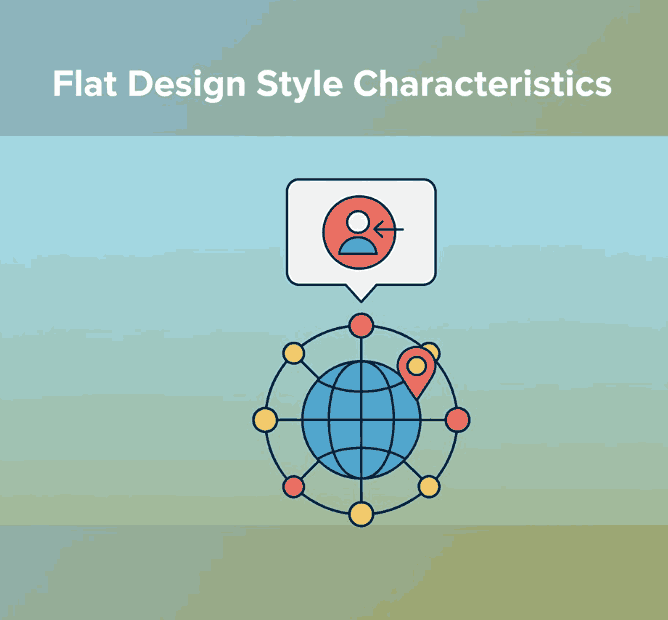
Table of Contents
- Introduction
- What Is Flat Design Style?
- The Origin of Flat Design
- Key Characteristics of Flat Design
- 4.1 Minimalism and Simplicity
- 4.2 Bold and Vibrant Colors
- 4.3 Clean Typography
- 4.4 Geometric Shapes and Icons
- 4.5 Focus on Functionality
- Benefits of Using Flat Design
- Flat Design in Branding and Typography
- Recommended Fonts for Flat Design Projects
- Conclusion
- References
1. Introduction
In today’s world of digital design, Flat Design Style Characteristics has become one of the most popular and influential visual styles. Known for its clean, minimal, and modern look, flat design eliminates unnecessary textures, shadows, and gradients, focusing instead on clarity and usability.
This article explores the characteristics of flat design style, its evolution, and how designers can use it effectively in branding and typography. If you’re looking to elevate your visual identity or UI project, understanding flat design is essential.

2. What Is Flat Design Style Characteristics?
Flat Design is a minimalist approach to user interface and graphic design that emphasizes functionality and simplicity.
Instead of imitating 3D effects or realistic textures (like in skeuomorphism), flat design uses solid colors, clean lines, and two-dimensional elements to convey information efficiently.
Flat Design became popular with tech giants such as Microsoft (Windows 8) and Apple (iOS 7), who adopted the style to create user-friendly, visually clear interfaces.
3. The Origin of Flat Design Style Characteristics
The concept of Flat Design can be traced back to Swiss Style or International Typographic Style from the 1950s, which focused on clarity, readability, and grid-based design.
When digital interfaces became mainstream, designers adapted these principles into a new digital form—resulting in Flat Design.
Its resurgence in the 2010s was a reaction against the heavily textured, skeuomorphic designs that dominated early smartphone interfaces. Designers began favoring cleaner, faster-loading visuals suitable for mobile and responsive environments.
4. Key Characteristics of Flat Design Style Characteristics
Let’s break down the defining Flat Design Style Characteristics that make it stand out.
4.1 Minimalism and Simplicity
Flat design embraces the “less is more” philosophy. Elements are stripped of unnecessary details, leaving only what’s essential. This creates a visually balanced layout that enhances readability and usability.
4.2 Bold and Vibrant Colors
Color plays a major role in flat design. Designers often use bright, contrasting palettes to draw attention and maintain visual interest. Common combinations include blues, oranges, purples, and greens that add energy without relying on gradients or depth.
4.3 Clean Typography
Typography in flat design is simple yet powerful. Sans-serif fonts are typically used for their readability and modern feel.
Fonts with clean lines, strong weight, and geometric proportions enhance the flat aesthetic by aligning with its functional and minimalist principles.
4.4 Geometric Shapes and Icons
Flat design relies heavily on geometric shapes, such as circles, rectangles, and triangles, to create icons and layouts. These elements contribute to a consistent visual system that users can understand instantly.
4.5 Focus on Functionality
Every element in flat design serves a purpose. Buttons, icons, and text are designed to communicate quickly and clearly, ensuring that usability remains at the core of the design.
5. Benefits of Using Flat Design Style Characteristics
Flat Design isn’t just aesthetically pleasing—it offers several practical benefits:
- Faster loading times: Fewer textures and effects mean lighter graphics.
- Improved user experience: Simple layouts help users navigate more intuitively.
- Better scalability: Works well across different screen sizes and devices.
- Timeless appeal: Minimalist designs age more gracefully than trend-heavy styles.
Because of these advantages, Flat Design remains a favorite among web designers, app developers, and branding experts.
6. Flat Design Style Characteristics in Branding and Typography
Flat Design extends beyond digital interfaces—it influences brand identity, logos, and typographic systems.
Modern brands use flat-style logos for clarity and adaptability. Think of brands like Spotify, Dropbox, and Google, which use minimal geometric forms and bold colors for maximum recognition.
Typography plays a crucial role in achieving harmony within flat design. Fonts must be readable, modern, and visually aligned with the overall design concept.
Here’s where custom or calligraphic fonts come in: adding a touch of human warmth to otherwise minimalist compositions.
7. Recommended Fonts for Flat Design Style Characteristics Projects
Here are some font recommendations from CalligraphyFonts.net that pair beautifully with Flat Design aesthetics:
- Overcame Font – A strong and minimalist sans-serif perfect for bold titles or UI elements.
- Faint Green Font – Elegant and modern, ideal for branding that requires clarity and a natural flow.
- Creatoria Font – A clean and stylish display font, excellent for flat-style logos and posters.
- Aesthetic Sunset Font – Adds a soft, artistic touch while maintaining simplicity—great for lifestyle or creative brands.
Using the right font enhances your flat design project’s visual balance and emotional tone, making your brand more memorable and consistent.

8. Conclusion
The Flat Design Style Characteristics showcase the perfect balance between simplicity and function.
By focusing on minimalism, bold colors, and clean typography, designers can create visuals that are not only beautiful but also user-friendly and efficient.
Whether you’re working on a brand identity, mobile app, or website UI, flat design offers a timeless framework for visual communication.
To elevate your design projects, choose fonts that align with flat design’s clarity and purpose—explore more typefaces at CalligraphyFonts.net and bring simplicity to life.
9. References
- Interaction Design Foundation – Flat Design
- 99Designs – Flat Design: The Ultimate Guide
- Canva Learn – Flat Design: The Basics
- Din Studio – Flat Design Style and Its Characters
